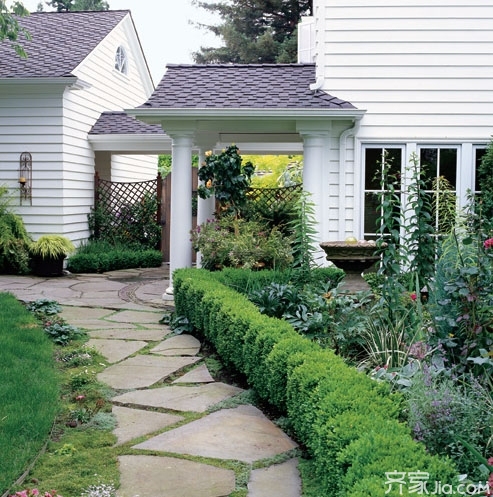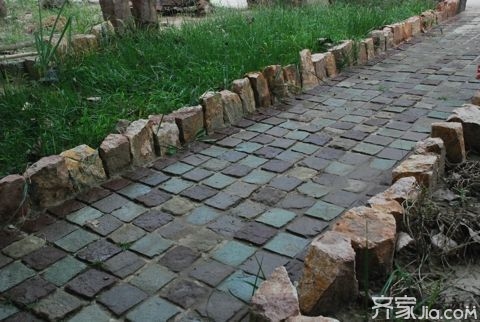The courtyard ground paving project is mainly paved with paved roads. The quality of courtyard paving works is directly related to the effect of the entire courtyard project. The park road mentioned here refers to various pavements such as roads, passages, and corridors in the green space. So, what are the essentials for construction of the courtyard ground paving ? Let's take a look together. First, the ground pavement construction process 1, construction preparation (1) Material preparation Park Road paving project, paving materials preparation work is relatively large, in order to determine the program should be based on the actual size of the paving plaza on the plans to loft, to determine the programme corner adjustment problems and the square and Park Road junction The transition plan, and then determine the number of various granite and scrap specifications, quantity. Because in the actual construction, the above problems are often encountered. (2) Site lofting According to the construction coordinate grid drawn by the design drawing, all the coordinate points are set on the site and piling. Then, based on the coordinates of the pile point, according to the square design map, the site boundary is released on the site ground, the scope of the main ground facilities and the excavation area. The zero line between the fill area. (3) Terrain review The vertical plan of the square of the same road is checked and the terrain of the site is reviewed. Each coordinate point. The natural ground elevation data of the control point, if any, must be measured and supplemented at the site. 2, site formation and slope (1) Excavation and fill construction The filling sequence of the filling area should be deep and shallow first. Fill the deep layer first, fill in the shallow depth, and fill one layer for each layer. Until the elevation of the design. The fertile soil suitable for planting excavated in the excavation process should be temporarily stacked on the side of the square and later filled into flower beds. (2) Site formation and slope searching After the completion of the excavation and filling works, the new ground to be excavated and filled will be sorted out. To level the ground, change the flatness of the ground to within 0.05m. According to the point filling and excavation height data and the designed slope data indicated by each coordinate pile, the site is sloped to ensure that the ground in all parts of the site basically reaches the designed slope. According to the existence of buildings, garden roads, pipelines and other factors beside the site, determine the vertical connection of the edge zone and adjust the elevation of the connection point. Also confirm the position of the ground drainage outlet, adjust the elevation of the bottom of the drainage ditch pipe, so that the ground floor of the square is more natural to connect with the surrounding ground, and the contradictions such as drainage and passage are reduced to the minimum. 3, ground construction (1) Grassroots construction Construction procedures: paving gravel, a constant pressure, a bulk of filler material, a compaction, a stall, and a caulking joint material. Paving gravel: can be used a few pieces of wood or brick about 10cm on the basis of the turmeric after the turf, using artificial paving gravel (crushed stone strength is not less than 8, different hard and soft stone can not be used ). With a calibrated paving thickness, wood blocks or bricks move with the shop. The gravel is once crushed on the paving and the iron fork is used for feeding. The size of the granules is required to be evenly distributed, and the vertical and horizontal sections meet the required thickness. The dust on the bottom of the material should be cleared. Voltage regulation: First use 10-12T roller to roll, the grinding speed should be slow, about 25 ~ 30m per minute, the rear wheel overlap width 1/2, first along the repaired road shoulder rolled together, reciprocating pressure twice, start Press from the edge of the road to the center. After roller compaction, the road arches and flatness were inspected using road arch bridge plates and small wire ropes. Partially uneven, it is necessary to go high. To go high is to evenly remove the excess gravel and must not be shovelled out with shovels. The padding is to loosen the low-lying part and spread the gravel evenly. After meeting the elevation, sprinkle a small amount of water and continue rolling until the initial stability of the gravel is not significantly displaced. This stage is generally required to press 3-4 times. Sprinkle material: Coarse sand or lime soil (8% to 12% of lime dosage) is evenly spread on the gravel. Use a broom to sweep into the gravel joint. Sprinkle the water evenly with a sprinkler or watering can. The void from the flow of water is then replenished with sand or ash so that there are no more voids and the tip of the gravel is exposed. Compaction: Use 10-12T roller to continue rolling, slightly faster speed, 60-70m per minute, generally grinding 4 to 6 times (depending on the soft and hard stone may be), avoid rolling too much, so as not to stone too broken. Sprinkle caulking material: After compaction of large pieces of rubble, immediately use 10-12T roller to carry out roller compaction, generally rolling 2 or 3 times, rolling until the surface is flat and stable and there is no obvious wheel track. Roller compaction: After the jointing material is well-distributed, immediately use a 10-12T roller to perform roller compaction. The 10-12T roller is used for roller compaction. Generally, it needs to be pressed for 2 to 3 times, and rolling is performed until the surface is flat and stable without significant wheel marks. Then carry out quality appraisals and visas. (2) Construction of a stable layer The first is to put the line at a fixed point on the finished grassroots level. Every 10cm is a point. According to the design elevation, the middle line and the side pile are placed on the edge line. Place baffles on the entire side of the square. The height of the baffle is more than 10cm, but not too high, and the baffle has a good elevation line. The second is to review and confirm the correctness of the square line and design elevation points before entering the next process. The third is to sprinkle a layer of water or l:3 mortar on the dried base before pouring the concrete. Fourth, according to the design of the proportion of materials, preparation, pouring, concrete coagulation seven, and with a ruler more than 1m long and flatten the top, the top slightly dry, and then use plastering sand to the design of the island. Construction should pay attention to making the cross slope and vertical slope of the road. Fifth, after the completion of the construction of the concrete surface, the maintenance should be started in time. The maintenance period is more than 7 days, and the maintenance period after the winter construction should be a little longer. Wet straw can be used. Wet sand and plastic film covering the road for curing. 4, surface construction (1) Construction preparation Material: Types of stone. Specifications. Patterns. Colors are accepted according to design drawings and should be stored in categories. Operating conditions: The first is to do a good wall surface. Ceiling (ceiling). The ceiling and floor waterproof and protective layer. Second, the construction of the embedded parts of the door frames and floors and the pipelines for hydropower equipment were completed and the inspections passed. The third is a variety of riser holes and other gaps should be filled with fine stone concrete plugging (small gap can be cement mortar filling). The fourth is to use a horizontal ink line of +50cm around the wall. Each question asked about the center line (crosshair) and flower sample separation line. (2) Operation process One is to clean the back of the stone plate first and keep it wet when laying. The second is based on the horizontal line. The center line (crosshairs), according to the number of pre-arrangement of each bay and the corridor on both sides of the standard line (closed road), and then pull the line. Thirdly, the grassroots should be watered and moistened before laying, and then the cement slurry should be brushed (the cement ratio should be around o.5). The cement slurry should be used with the brush to spread mortar, and there should be no air drying phenomenon. Fourth, dry hard cement mortar (usually with a mixing ratio of 1:3 to moist loose. Hand clumps do not drain water prevail) leveling layer, virtual shop thickness to 25 ~ 30cm is appropriate, put on the stone plate higher It is advisable to finish the surface by about 3-4cm.) Use iron trowel (gray spoon) to make a smooth trowel. Then pre-pave the stone slabs and align the vertical and horizontal joints. Tap the middle of the board with a wooden hammer and tap the mortar to lay it. After the height, lift the slate, check the surface of the apricot mortar and the slate base (if any, fill with mortar), sprinkle water on the surface of the mortar first with a watering can, then spread evenly a layer of cement powder, align the stone plate Paving. The four corners of the shop should be landed at the same time. Use a wooden hammer to knock hard to levelling. Second, construction precautions (1) Avoiding Common Problems in Engineering Quality First, empty stone plate and base: mainly due to grassroots clean up; there is not enough moisture; combined layer mortar is too thin (mortar virtual shop generally should not be less than 25-30mm, block seats should not be less than 20ram thick); The combination mortar is not full and the water-cement ratio is too large. Second, the size of the wall appears: because the room is separated by the net size is not square: Paving does not accurately grasp the board slot, and the control of the size of the choice of materials is not strict enough. Third, the adjacent two boards are uneven: due to the unevenness of the plate itself; improper operation during paving: after the paving, people step on the plate, etc. (sometimes loose plate phenomenon occurs), and it is forbidden to trample on the person within two days after paving. . (2) Major safety measures First, when loading and unloading stone slabs, gently handle them to prevent them from pinching or stomping. The second is the use of portable electric vehicles, pass the test run qualified, and install leakage protection switch and reliable grounding device, the operator must wear protective glasses and insulating rubber gloves. Third, when using the steel derrick for vertical transportation, the upper and lower signals should be contacted, and the loading and unloading operations must be performed until the cage is stable. Fourth, when cleaning the ground, it is not allowed to throw debris from the window, balcony, or hole left. The fifth is the night shift and operation in the dark, should use 36V low voltage lighting. Basement lighting uses no more than 12V. The above is a brief introduction to the courtyard ground pavement construction essentials, and I hope to help you. For more information, please visit this website. Stay tuned. Floor tiles Stainless Steel Rod,Stainless Steel Bar,Metal Rod,SS Rod Torich International Co.,Ltd--The Steel Tube Maker , http://www.chinasteeltubepipe.com


Huang Xiaoming shares with you: courtyard floor pavement construction essentials
